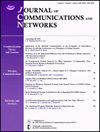基于Lyapunov算法的延迟敏感SAGIN联合卸载与资源分配
IF 3.2
3区 计算机科学
Q2 COMPUTER SCIENCE, INFORMATION SYSTEMS
引用次数: 0
摘要
移动边缘计算(MEC)与天空地一体化网络(SAGIN)的融合,在显著降低用户任务处理延迟的同时,缓解了核心网的数据压力,从而满足SAGIN海量连接带来的计算能力、吞吐量和时延的性能要求,是当前6G网络研究的重要方向。在本研究中,我们专注于在SAGIN框架内优化用户延迟和使用成本,该框架包括低地球轨道(LEO)卫星、高空气球(HAB)和地面用户。具体而言,地面用户采用部分卸载策略,其中计算任务通过hab卸载到由LEO卫星托管的MEC服务器进行处理。为适应卫星星座的高动态性,提出了以长期平均时延最大化、成本最小化为目标的优化问题,并引入Lyapunov优化方法进行求解。仿真结果表明,该算法在保证系统稳定性的同时,能有效降低网络时延和用户使用成本。本文章由计算机程序翻译,如有差异,请以英文原文为准。
Joint offloading and resource allocation based on Lyapunov algorithm in delay-sensitive SAGIN
The integration of mobile edge computing (MEC) and space-air-ground integrated network (SAGIN) can significantly reduce the user's task processing delay, while relieving the data pressure on the core network, so as to meet the performance requirements of computation capability, throughput, and delay brought about by the massive connectivity of SAGIN, which is an important direction for current research on 6G networks. In this study, we focus on optimizing user delay and usage costs within the SAGIN framework, which comprises low Earth orbit (LEO) satellites, high altitude balloons (HAB), and ground users. Specifically, ground users adopt a partial offloading strategy, wherein computational tasks are offloaded via HABs to MEC servers hosted by LEO satellites for processing. To accommodate the highly dynamic nature of the satellite constellation, we formulate an optimization problem aimed at maximizing the long-term time-averaged latency while minimizing costs, and introduce the Lyapunov optimization method to solve it. The simulation results demonstrate that our proposed algorithm can effectively reduce the network latency and user's usage cost, while ensuring system stability.
求助全文
通过发布文献求助,成功后即可免费获取论文全文。
去求助
来源期刊
CiteScore
6.60
自引率
5.60%
发文量
66
审稿时长
14.4 months
期刊介绍:
The JOURNAL OF COMMUNICATIONS AND NETWORKS is published six times per year, and is committed to publishing high-quality papers that advance the state-of-the-art and practical applications of communications and information networks. Theoretical research contributions presenting new techniques, concepts, or analyses, applied contributions reporting on experiences and experiments, and tutorial expositions of permanent reference value are welcome. The subjects covered by this journal include all topics in communication theory and techniques, communication systems, and information networks. COMMUNICATION THEORY AND SYSTEMS WIRELESS COMMUNICATIONS NETWORKS AND SERVICES.

 求助内容:
求助内容: 应助结果提醒方式:
应助结果提醒方式:


